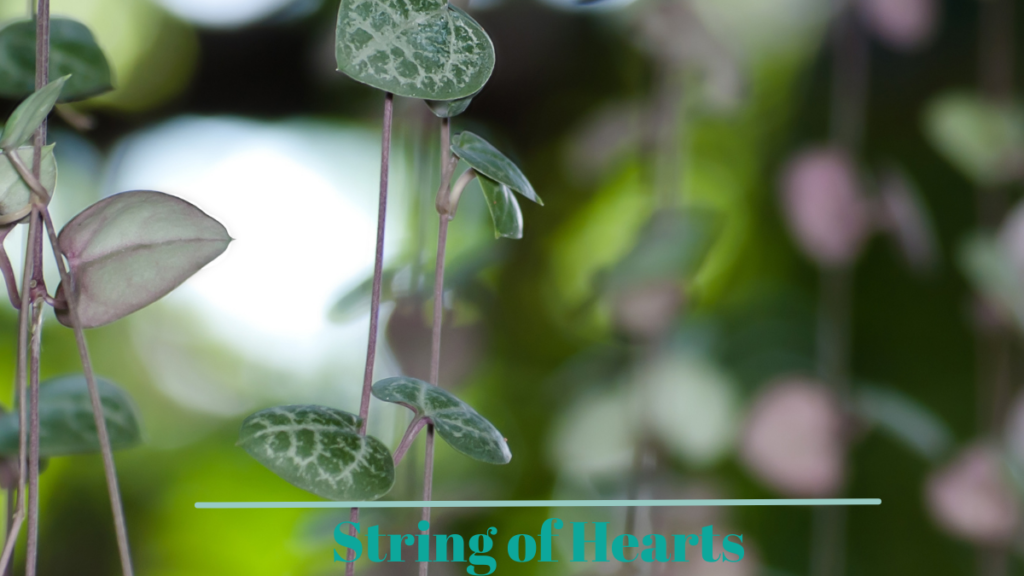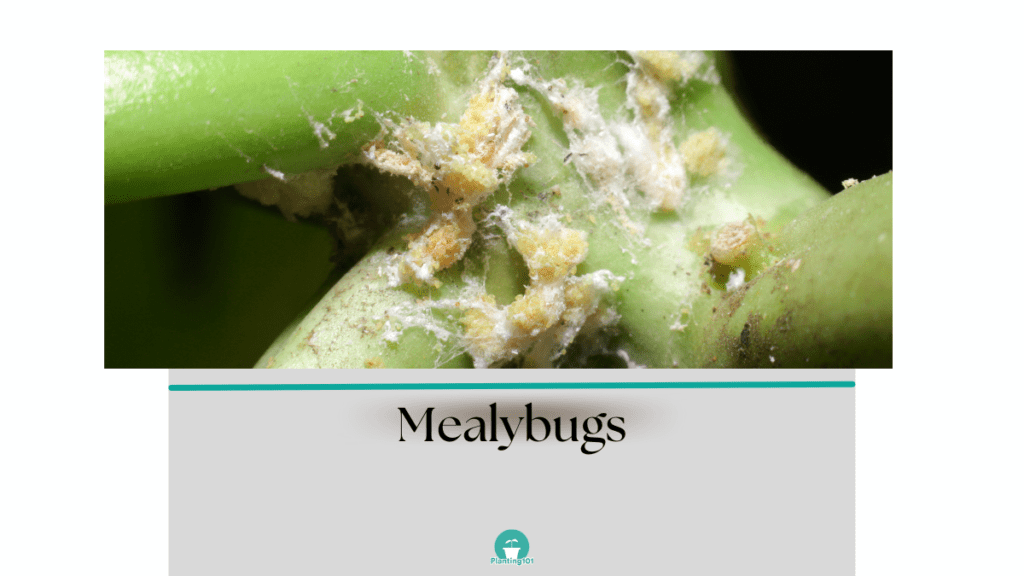String of Hearts (Ceropegia woodii) is a hanging houseplant that grows best in sunny locations. It is a fast-growing houseplant that looks great in a hanging basket with cascading heart-shaped leaves. Here is a beginner’s guide on how to care for your String of Hearts at home.

String of Hearts Houseplant Care at a Glance
| Name | String of Hearts |
| Scientific Name | Ceropegia woodii |
| Light | Bright Indirect Light. Can Tolerate Medium Light. |
| Daytime Temperature | 70 to 80 F (21-26C) |
| Night Time Temperature | 60 to 70 F (15-21C) |
| Water | Low to Moderate Water |
| Humidity | Moderate Humidity |
| Potting | Well-draining, organic, cactus potting mix |
| Fertilizer | Once every 2 weeks from Spring to Fall. Don’t fertilize in the winter. |
String of Hearts: Common Names
String of Hearts is also called Rosary Vine, Bushman’s Pipevine, Lantern Flower, Necklace vine, Chain of Hearts, Collar of Hearts, Hearts Entangled, Parachute flower, and Wine-glass vine.
String of Hearts: Varieties
The variegated type is a popular variety – C. woodii f. variegata
String of Hearts: Size
String of Hearts plants are hanging houseplants with long stems that can grow to 12 feet long. It is a fast-growing houseplant so you’ll need to trim your String of Hearts occasionally.
Light
String of Hearts: Sun or Shade?
String of Hearts will grow best in a sunny location. Place it in a south-facing or west-facing window. It can also tolerate partial direct sun.
Water
How Often Should You Water Your String of Hearts?
String of Hearts have succulent leaves which means water is stored in the leaves. It does better in dry conditions than in soggy soil. Let the soil dry out halfway down the pot before watering.
How Do You Know When to Water Your String of Hearts?
Water your String of Hearts when the soil feels dry. The best way to tell when it’s time to water is by sticking your finger into the soil. Stick your finger in the soil 2 inches deep. If the soil feels dry, it’s time to water your String of Hearts. If in doubt, it’s best to not water your String of Hearts. Your String of Hearts will do better in dry conditions than in soggy soil.
What Type of Water Should You Use When Watering Your String of Hearts?
Your String of Hearts can be watered with tap water but be mindful of the water temperature that you are using to water your String of Hearts. Don’t use straight cold water from the tap to water your String of Hearts. String of Hearts prefers cool water that is not hot and not cold. When you turn on the cold water from the faucet add a little bit of warm water.
You can also get to this ideal temperature by filling a watering can or pitcher with water and leaving it out overnight until the water is at room temperature. Your String of Hearts can be sensitive to the minerals in tap water, so if you see brown tips on its leaves, you may need to switch to watering your String of Hearts with distilled water or rainwater.
How Do You Make Sure There is Proper Drainage for Your String of Hearts?
Good drainage is essential, you don’t want your String of Hearts to sit in soggy soil. Make sure there are drainage holes at the bottom of the pot. After watering your String of Hearts and you see water draining out of the pot’s drainage holes, make sure you empty out the accumulated water in the saucer. Don’t let your String of Hearts’ pot sit in this puddle of water. It will cause root rot!
Do You Need to Mist Your String of Hearts?
Your String of Hearts is a houseplant that does not need additional misting and will do well in regular indoor air.
Soil
What Type of Potting Mix is Best for Your String of Hearts?
Your String of Hearts needs a well-draining, organic cactus potting mix.
How Do You Know When To Repot Your String of Hearts?
Your String of Hearts does not need to be repotted frequently. It actually thrives in crowded conditions. Repot only when it looks like it is outgrowing its current pot. It’s best to repot String of Hearts in the Spring.
Fertilizer
Do You Need to Fertilize Your String of Hearts?
Your String of Hearts should be fertilized once every 2 weeks from Spring to Fall. Don’t fertilize in the winter.
What Fertilizer Should You Use on Your String of Hearts?
Use cactus food to fertilize your String of Hearts.
Propagation
How Do You Propagate Your String of Hearts?
Your String of Hearts String of Hearts Plant is easy to propagate. You can propagate your String of Hearts plant by stem cutting. Below are steps on how to propagate the String of Hearts Plant by stem cutting:
1. Plant a Tuber from Your String of Hearts
You will see these pearl-shaped tubers growing on the vines of your String of Hearts. Simply plant one of these tubers into moist soil in another pot. Don’t cut the tuber from the vine.
2. Cut the String of Hearts Tuber from the Mother Vine
Allow the String of Hearts tuber to grow roots. Be patient, this can take weeks or months. Once the tuber has rooted, you can cut the tuber from the mother vine. Gently tug on the tuber, if there is resistance, you know it has roots.
Common Problems of String of Hearts Plant Care
The most common problems that affect String of Hearts are mealy bugs.
String of Hearts Plant Problem: Fluffy White Growth In Between the Leaves and Stems of your String of Hearts
Problem: There are fluffy white growths in between the leaves and stems of your String of Hearts.

Cause: Mealybugs are causing the fluffy white growth on your String of Hearts. It is a common houseplant disease.
Solution: To get rid of mealybugs on your String of Hearts, wash your plant with water. You can also use soapy water. Spraying rubbing alcohol on affected areas can also get rid of mealybugs. Horticultural oil and insecticidal soap are also effective in getting rid of mealybugs.
Check out our article on how to make your own homemade pesticides using baby shampoo: How to Make Horticultural Oil and How to Make Insecticidal Soap
You May Also Be interested in these Hanging Houseplants
How to Care for your Pothos (Epipremnum aureum)
How to Care for your Satin Pothos
How to Care for your Heartleaf Philodendron
How to Care for Your String of Pearls Plant
How to Take Care of Your Boston Fern (Nephrolepsis exaltata)

